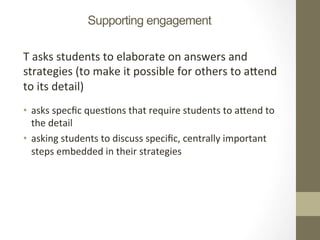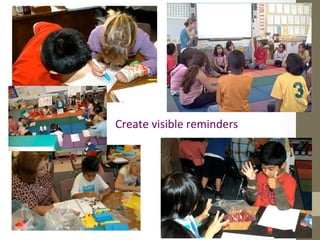Franke productive struggle_5pmtalk
- 1. Supporting students in “productive struggle”: What can teachers do? Megan Franke UCLA
- 2. The Issues • Students need the opportunity to work and wrestle with mathema;cs (Hiebert & Grouws, 2007) • expending effort to make sense of mathema;cs and figure out something that is not immediately apparent • Common Core Standards for Mathema;cal Prac;ce call for students to “construct viable arguments and cri;que the reasoning of others” including jus;fying their conclusions, communica;ng them to others, listening to the arguments of others, responding to the arguments of others, deciding whether they make sense, and asking useful ques;ons to clarify or improve the arguments • How can teachers produc;vely engage students in wrestling with mathema;cs?
- 3. Maggie had 3 packages of cupcakes. There were4 cupcakes in each package. She ate 5 cupcakes. How many cupcakes are leW?
- 4. Adam has 21 cents. Gumdrops cost 3 cents. How many gumdrops can Adam buy?
- 5. Student explanations in mathematics classrooms • Related to student achievement • Our research • Others: Gillies, Webb & Mastergeorge, Safard & Kieran, Nathan & Knuth • Not just any explaining – details ma_er • Teachers can support students to explain • O’Connor & Michaels, Gillies, Mercer • Ini;al ques;on: how did you get that? not sufficient • 98% of the ;me teachers asked • Probing ques;ons (sequences), leading ques;ons, bundled ques;ons
- 6. Multiple Dimensions of Student Communication • Explaining their own thinking • Engaging with others’ thinking • You engage with others’ ideas • Others engage with your ideas 6
- 7. Engaging with each others’ ideas Referencing/acknowledging somebody’s ideas in general without details • I used Nomi’s strategy • “Does everyone agree with Sam?” S says no. • Students point to strategy like their own Addressing the student’s idea with detail • repea;ng what was already said or wri_en on the board • sharing someone else’s strategy for them • disagreeing while referencing detail of what they disagree with Addressing the detail of someone’s idea and contributes to someone else’s ideas • S disagreeing with what was shared and shares an alterna;ve • responds to a S’s shared idea and adds to it • construct strategy together
- 8. • Explain your thinking • Engage with others’ ideas to a high degree • Have others engage with your idea to a high degree 8
- 9. Relationship between Student Participation and Achievement Par%al correla%on with achievement Provided fully-‐detailed explana;ons of how to solve the problem .30* Highest level at which you engaged with other students’ ideas .44* Highest level at which other students engaged with your ideas .41* 9
- 10. If Seily has Iive-‐thirds liters of soda, what would that look like? Draw and label all parts
- 11. Some Observations about the Teacher Practices • Teachers made a variety of ini;al moves to help students a_end to each other’s ideas • These moves all concerning having students compare their ideas to other students’ ideas • Do you understand what Adrian did? • Do you agree? • Is your approach the same or different? • Point to the solu;on that is like your own • Can you explain what he did? • More important than the ini;al move for how students engaged with others’ ideas was how the teacher followed up to press students to make their thinking explicit 11
- 12. Supporting engagement T directed students to discuss answers and strategies with each other (norm moves) • You are not talking to me, points to the class, you have to convince them • Emmy is not convinced yet so lets see if we can get some more ideas • Carlos are you paying a_en;on, you want to see if you agree with her
- 13. Supporting engagement T asks students to elaborate on answers and strategies (to make it possible for others to a_end to its detail) • asks specfic ques;ons that require students to a_end to the detail • asking students to discuss specific, centrally important steps embedded in their strategies
- 14. Supporting engagement T posi;ons students to par;cipate in another’s thinking • Selects strategies that are different to be shared with the whole class • Have more than one set of work shared and explained on the board for each problem • Asks students to offer sugges;ons to each others strategies • Did you do it the same way – how is it the same? • I love what you did….. Look at this Lily, because Cole is at the same place where you are.” • Cris maybe it will help if you listen to someone else and then try again
- 15. Disrupting existing cultural practice • Exis;ng prac;ce, expected, experienced • Dinner ;me conversa;on • Teachers, students and families all have ways they are used to doing school math • Classrooms, schools, districts • Requires renego;a;on rather than telling
- 16. Create a space to begin… Count by 1, start 180, count to 230 Count by 7/8 Count by .004 start at 53.280 Count by 10 start 66, count to 266 Count by .99, start at 1 Count by 2, start at 0 Count by 11, start at -77
- 17. One of these things is not like the others… Listen… replace your talk with another move
- 19. Consider what gets displayed
- 20. Tasks with mul;ple entry points What do you notice? • 6 x 2 = 3 x 4 • 12 x .5 = .25 x 24 • 416 x 2 = 4 x 208 True or False 26 + 18 - 18 = 25 17 - 9 + 8 = 17 7+6=8+5 67 + 83 = 66 + 82
- 21. Transform the Textbook pages Ask: Circle all the number sentences with an answer less than 5.
- 22. Draw on non-‐school tasks..
- 23. Productive struggle for each student • Challenge our assump;ons about student par;cipa;on • Find the produc;ve – what students have communicated • Make explicit what it means to par;cipate (norms) • Support it (follow up) • Watch for how the status quo limits opportuni;es…find ways to challenge it






















